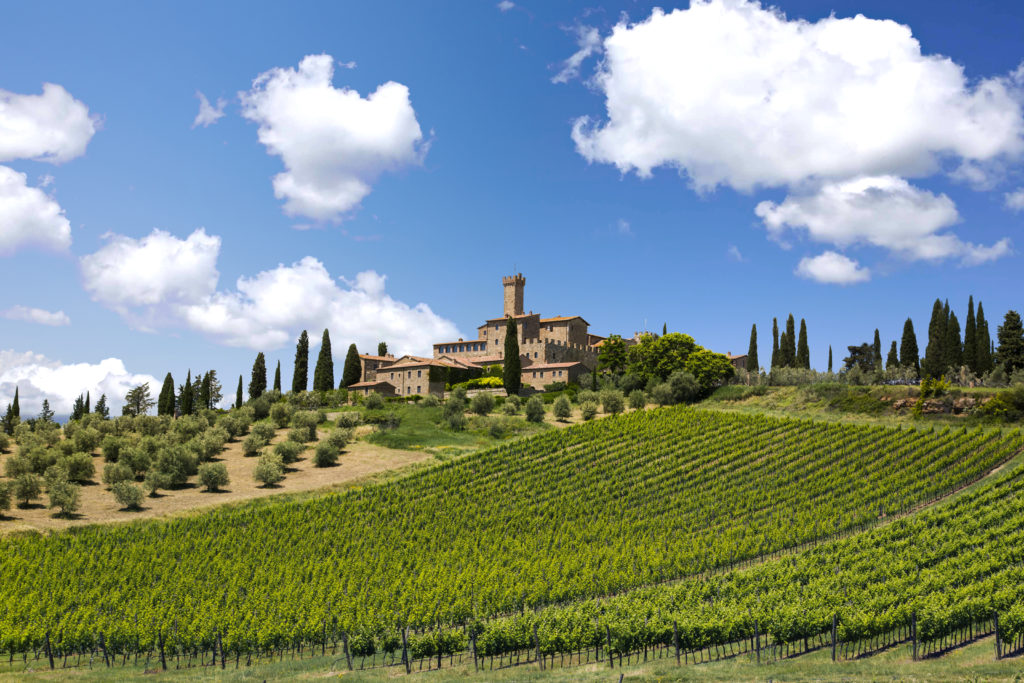It was rumoured last year that LVMH was buying Brunello specialist Banfi wines, but the deal never happened – and we reveal why.

It would have been a brilliant fit for LVMH, a business that is gradually building its top-end wine portfolio and has a no Italian brand, let alone a revered Brunello estate such as Castello Banfi.
Banfi would have been great for LVMH: the Italian wine brand comes with a historic castle – a cornerstone for an authentic, luxury image that LVMH looks for in labels. Plus, Banfi has a vast, sustainably-managed estate – LVMH wants scalable premium brands with strong green credentials – and Banfi has a powerful presence in the US, a market where LVMH is looking to grow its footprint.
But the buyout never happened, and that’s the result of one person’s drive and vision – Banfi president Cristina Mariani-May, the daughter of John Mariani, who co-founded the Banfi wine brand in the 1978 with his brother Harry, following the purchase of the Poggio alle Mura estate in Montalcino, now called Castello Banfi.
Motivated by a desire to keep a major family involvement in the operation, which comprises the largest contiguous estate in Europe with almost 3,000 hectares – one third of which is planted with vines – Cristina decided not to sell Banfi to LVMH.
She admitted during an interview with db earlier this year that there were “discussions” with the luxury wine and spirits group, which, as reported by db back in February 2020, could see LVMH acquire the entire Banfi wine production business – an operation with a 7 million bottle output and a near €70m turnover (2018), which is fuelled by Montalcino’s Castello Banfi, along with estates in the Maremma, Bolgheri, Chianti, Chianti Classico and Piedmont.
Cristina also told db that she was in talks with LVMH because she needed to raise funds, commenting, “They [LVMH] were interested in Italy, and I was looking for capital.”
The reason why Cristina needed money concerned the way Banfi was structured – the company, like many family-owned businesses – had a number of shareholders, with different aims.
“The estate was split up between different family members and some people wanted their cash out, which is how family companies start to break apart,” she said, adding that this tends to start to occur with the third generation, of which she is a part (Banfi in fact began life in 1919 as a wine importer, when Cristina’s grandfather started bringing Italian wines to American consumers).
Moving forward 100 years to talks in 2019, LVMH could have provided the funds needed to buy out those family members who wanted to leave Banfi’s Italian wine making business, but at the same time, it would have seen Cristina and the family lose control of the estate.
As Cristina said, “They [LVMH] would normally take a majority shareholding, and then buy the rest out.”
Continuing, she recalled, “That didn’t sit well with me; I love this business, and I have children, and I want them to come into it.”
Continuing, she said that should LVMH take a stake in Banfi, it would take her away from influencing the strategic direction of the brand. “I didn’t want to be a figurehead, I wanted to be a businessman too, so I found another way out,” she recalled.
 This other way out has seen Cristina secure the backing to become “the majority owner” of the Banfi estate, making her the leader of the Italian wine production side of the business (Banfi still has a separate US wine importing operation, Banfi Vintners, as well as two US wine brands: Washington State’s Pacific Rim Riesling and Oregon’s Rainstorm Pinot Noir).
This other way out has seen Cristina secure the backing to become “the majority owner” of the Banfi estate, making her the leader of the Italian wine production side of the business (Banfi still has a separate US wine importing operation, Banfi Vintners, as well as two US wine brands: Washington State’s Pacific Rim Riesling and Oregon’s Rainstorm Pinot Noir).
Such a newly-strengthened position for Cristina has allowed her to take a “deeper focus” in the Italian property, which has meant “more investment” in the hospitality side of the business at Castello Banfi, where a 14th century castle houses a boutique hotel that’s now listed with Relais & Châteaux. Meanwhile, its restaurant has gained a Michelin star, and the Montalcino property now hosts an annual jazz festival.
The reason for a focus on tourism centres on Cristina’s belief in the power of experiential marketing for brand building, as well as her urge to educate consumers. She’s also driven by a desire to “give back” to the industry when it comes wine research, and appears especially wedded to Banfi’s foundation Sangue di Jove, which she describes as a “think tank on Sangiovese”.
Overall, such a change in ownership structure has given Cristina the opportunity to concentrate on Castello Banfi as a wine brand, a hospitality business and centre for Sangiovese research.
“We used to be distracted by tertiary brands and building other people’s brands [via the company’s US import business], but now we are more focused on the Banfi brand and getting it out there as the world opens up,” she said.
For this, she adds, “It is very important for me to have it privately held.”
Comparing the situation with fellow Brunello producer Biondi-Santi, which sold a controlling stake in 2017 to EPI, the owners of the Charles and Piper-Heidsieck Champagne brands, Cristina said, “While the family are still at the estate, Biondi-Santi is owned by a private equity group.”
“We have the largest contiguous estate in Europe, and we want to protect it,” she said.
“It’s a conservative approach, but one that’s right for my family,” she concluded.
Read more
LVMH in takeover talks with Castello Banfi


